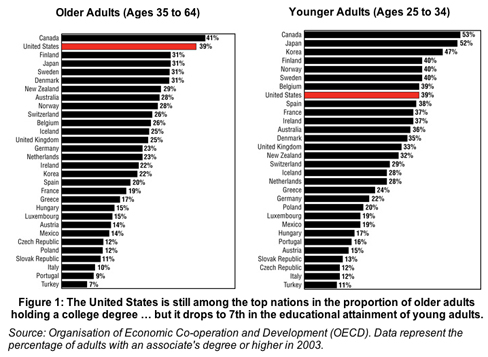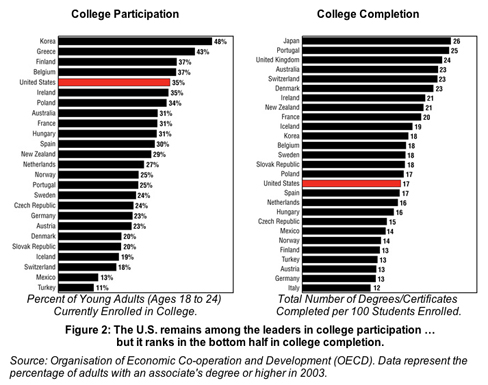From: Rakesh Bhandari (bhandari@BERKELEY.EDU)
Date: Sun Feb 18 2007 - 23:05:09 EST
The Decline of Public Higher Education
by Rick Wolff
Over the last quarter century, Americans got used to the idea of
their children going on to colleges and universities. In the early
1970s, about <http://nces.ed.gov/fastfacts/display.asp?id=98>8.5
million Americans attended such institutions; by 2004 the number had
<http://nces.ed.gov/fastfacts/display.asp?id=98>doubled. The US
<http://www.census.gov/population/www/censusdata/hiscendata.html>population
across this time rose by less than 50%. This spectacular growth in
our student population reflected the pent-up demand of the mass of
Americans for what they had viewed as a luxury as well as a ticket to
better jobs and higher incomes. The demand would have far exceeded
the supply had not most of the states rapidly increased facilities
for public higher education. Today, the vast majority of US college
and university students attend
<http://www.census.gov/compendia/statab/tables/07s0210.xls>public,
not private, institutions. Yet therein lies precisely the problem.
The last quarter century, and especially the last decade, have also
moved the country rightward towards less government provision of
social services (like public higher education) and more
privatization.
<http://mrzine.monthlyreview.org/wolff120606.html>Real wages have
stagnated since the 1970s, so most Americans are finding it ever more
difficult to pay for public higher education. Meanwhile its
<http://nces.ed.gov/fastfacts/display.asp?id=76>costs have been
<http://www.iht.com/articles/2006/10/25/america/web.1025tuition.php>rising
far faster than the general level of
<http://www.bls.gov/cpi/>inflation. We are on a collision course in
which a historic demand for higher education -- which has now become
an embedded expectation for half the population -- confronts a
rapidly escalating rationing of enrollment by cost. Social tensions
and rising resentment and anger are sure to follow.
Let's take the example of the main campus of a major state
university: the University of Massachusetts at Amherst.
Approximately 25,000 students, undergraduate and graduate, attend
that university. About three quarters come from Massachusetts
households. The total cost for in-state undergraduate students went
from $2,340 in 1978/79 to $16,584 this academic year. That increase
was three times as big as the rise in the consumer price index over
the same period. The increase was larger still for out-of-state
undergraduates. Given that real wages stagnated across this period,
paying for their children's college-level education presented
families with an ever rising level of financial difficulty. No
wonder the data show that American workers over the last 25 years
steadily increased the number of hours worked per year (multiple jobs
and/or more overtime). No wonder those families increased household
<http://mrzine.monthlyreview.org/wolff151005.html>debt at
historically unprecedented rates to historically unprecedented levels.
Nor is it any wonder that students now graduating US colleges and
universities do so with increasing levels of personal
<http://projectonstudentdebt.org/state_by_state-data.php>debt (in
addition to their parents' household debt) taken to pay part of
college costs. The US Department of Education says that in
2004-2005, two thirds of students graduated from colleges and
universities with debt (averaging $15,500 at public schools and
$20,000 at private schools). In New York, which runs the nation's
largest system of public higher education, the average debt was
$21,000 then, and it is higher today.
Several lessons flow from this situation. First, many parents have
reacted strongly to the additional stress and exhaustion (from the
<http://www.bls.gov/opub/working/page17b.htm>increasing hours of paid
work they have undertaken) and the additional debt anxieties (from
the fast rising levels of household debt) incurred since the early
1970s to finance runaway college costs. Some have turned against
higher education in a deepening rage about the financial burdens that
it imposes. This can take the form of hostility toward teachers and
<http://www.aaup.org/publications/Academe/2006/06ma/06matoc.htm>teachers'
salaries in so far as these are blamed for rising college costs. It
can take the form of a cultural turn against higher education: viewed
increasingly as an unnecessary and useless distraction from "real"
life and a job or as a luxury indulgence for the idle or both. Most
likely, anger about college costs will flow into the growing
<http://www.nytimes.com/2007/01/28/weekinreview/28leon.html?ex=1171688400&en=eebe0073544bbddc&ei=5123&partner=BREITBARTclass malaise" that fuels the rhetoric and campaigns of many
Democrats and mystifies so many Republicans (at least, those who
don't simply deny it or its basis in hard realities).
Nor have matters been improved as public universities, to save costs,
resort ever more to substituting
<http://www.aaup.org/AAUP/issuesed/contingent/contingentfacts.htm>overworked
and underpaid "adjuncts" for the full-time tenured faculty who used
to do most of the teaching. New PhDs face ever
<http://www.aaup.org/publications/Academe/2004/04jf/04jfbrad.htm>fewer
tenure-track jobs and so must take multiple adjunct positions at
different institutions. They have far less time for each class and
little or no time for the research that should enable them to keep up
with their discipline and improve their teaching across their working
life. Grossly underpaid in comparison to what tenure-track teachers
get, they resent their situation. Rising pressures not matched by
rising resources, respect, or remuneration also provoke more
dissatisfaction and resentment among the relatively shrinking portion
of tenured professors. The deteriorating circumstances of the
teachers spill over to diminish the educational experiences of the
students. The students have thus been required to pay ever more for
ever less in the way of educational services. What keeps students in
school is the terror of facing a deteriorating job market without a
degree. They remain students despite the quality of their classroom
experiences.
Nothing better illustrates all these trends than the current rapid
proliferation of
<http://nces.ed.gov/fastfacts/display.asp?id=80>"distance-learning"
-- the prevailing euphemism for internet-based courses. In them,
very low-paid adjuncts administer electronic courses that students
increasingly substitute for the formerly in-person engagement with
tenured professors. In many state universities, faculty reductions
have so limited classes that undergraduates find it necessary to add
<http://nces.ed.gov/programs/coe/2003/section3/indicator21.asp>an
extra semester or two (and its heavy costs) to get sufficient classes
to
<http://measuringup.highereducation.org/commentary/introduction.cfm%20>graduate
in their chosen major fields. Offering such students
"distance-learning" via the internet is proving
<http://archive.salon.com/tech/feature/2005/01/26/distance_learning/index_np.html>aprofitable
new opportunity for such universities.
The finance-driven turn to adjuncts and distance learning widens the
gulf between public and private higher education. The private
colleges and universities see the decline of public colleges and
universities as a competitive opportunity in the business sense. The
democratization of higher education had been notably advanced after
World War 2 when the states built up first-rate institutions that
often outperformed the best and oldest private institutions. Now,
that short-lived democratization is unraveling and with it the
quality of higher education provided to the majority of our students.
A differentiation of first (private) and second class (public)
higher education is hardening into the norm with many state and
community colleges sinking further into still lower quality
educational experiences. It would be hard to exaggerate the complex
consequences of these developments for many years and in many domains
of our society.
Click on the chart for a larger view.
<http://mrzine.monthlyreview.org/CollegeDegrees.jpg>
<http://mrzine.monthlyreview.org/CollegeParticipationCompletion.jpg>
SOURCE: The National Center for Public Policy and Higher Education,
<http://measuringup.highereducation.org/commentary/introduction.cfm>Measuring
Up 2006
<http://www.umass.edu/resnick-wolff/>
<http://www.umass.edu/resnick-wolff/>Rick Wolff is Professor of
Economics at University of Massachusetts at Amherst. He is the author
of
<http://www.umass.edu/resnick-wolff/Wolff_curriculum_vitae.pdf>many
books and articles, including (with Stephen Resnick)
<http://www.umass.edu/resnick-wolff/books.html>Class Theory and
History: Capitalism and Communism in the U.S.S.R. (Routledge, 2002)
and (with Stephen Resnick)
<http://www.amazon.co.uk/gp/product/0415770262/202-6233462-4423822?v=glance&n=266239
Departures in Marxian Theory (Routledge, 2006). This article first
appeared in <http://www.globalmacroscope.com/>Global MacroScope (at
<<http://www.globalmacroscope.com/>www.globalmacroscope.com/>).
<javascript:HaloScan('wolff170207');> Comment |
<javascript:HaloScanTB('wolff170207');> Trackback |
<http://mrzine.monthlyreview.org/wolff170207p.html>Print
<http://mrzine.org/>
<http://www.statcounter.com/>
From: Monthly Review webzine of 2/16/07:
<http://www.monthlyreview.org/mrzine/>http://www.monthlyreview.org/mrzine/




This archive was generated by hypermail 2.1.5 : Wed Feb 28 2007 - 00:00:08 EST